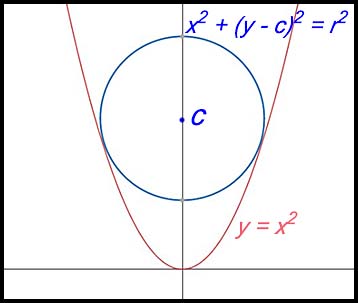Where the techniques of Maths
are explained in simple terms.
Quadratics - the Discriminant.
Test Yourself 1.
- Algebra & Number
- Calculus
- Financial Maths
- Functions & Quadratics
- Geometry
- Measurement
- Networks & Graphs
- Probability & Statistics
- Trigonometry
- Maths & beyond
- Index
To answer the following questions - you will need to use the discriminant:
- to calculate the value of the discriminant;
- to interpret the value directly;
- to find values.
| No real roots. | 1. Show that the equation x2 + 5x + 8 = 0 has no real roots. |
2. Show that the equation 2x2 - 12x + 25 = 0 has no real roots. |
| 3. For what values of p will the quadratic equation
x2 + (p - 2)x + 1 = 0 have unreal roots? |
4. Explain why the graph of the parabola described by the equation
y = 3x2 - 2x + 4 is located above the x axis for all values of x. |
|
| Real roots | 5.For what value of m are the roots of f(x) = mx2 + 6x - 3 real?
|
6. (i) Find the discriminant of the equation
3x2 + 2k + k = 0.
(ii) For what values of k does the equation
|
| 7. Show that x2 + kx + k - 1 = 0 has real roots for all values of k. | 8. | |
| One real root | 9. Find the value(s) of k for which the quadratic equation
3x2 + 2x + k = 0 has one real root. Answer. k = 1/3. |
10. Find the values of k for which the quadratic equation x2 - (k + 4)x + (k + 7) = 0 has equal roots. Answer. k = -4 or k = -8. |
| 11. For what value(s) of k does the equation y = x2 - 2kx + 6k have one real root? Answer. k = 0 or k = 6. |
12.
|
|
| Real and different roots. | 13. Find the value(s) of k if the roots of the equation x2 + kx + 36 = 0 are real and distinct. |
14. |
| 15. For the quadratic equation
x2 + (p - 3)x - (2p + 1) = 0
|
16. | |
| Mixed questions. | 17. For what values of k does
x2 - (k + 5)x + 9 = 0 have
|
|
| Positive definite. | 19. For what values of k is the equation kx2 - (k + 1) - 2k + 3 = 0 positive definite? | 20. For what values of k is the equation
(k + 1) x2 - 2(2 + k) + 3 = 0 positive definite? Answer. 4 - 2√6 < k < 4 + 2√6. |
| 21. | ||
| Negative definite. | 23. |
|
| 25. | 26. | |
| Advanced contexts. | 27. (i) Show that for all values of m, the line y = mx - 3m2 touches the parabola x2 = 12y.
(ii) Find the values of m for which this line passes through the point (5,2). (iii) Hence determine the equations of the two tangents to the given parabola from the point (5,2). |
|
|
28. The circle x2 + (y – c)2 = r2, where c > 0 and r > 0, lies inside the parabola y = x2. The circle touches the parabola at exactly two points located symmetrically on opposite sides of the y-axis, as shown in the diagram.
|
|
29. The parabola y = b - ax2 , where a > 0 and b > 0 , is under the curve  . .
The parabola touches the curve at two points that are symmetrical at the y-axis, as shown in the diagram above.
|
||
| 30. (i) Write down the discriminant of 2x2 + (k –2)x + 8, where k is a constant.
(ii) Hence, or otherwise, find the values of k for which the parabola
|
||
| Increasing functions. | 31. For what values of k is the curve y = x3 - 3x2 + kx + 3 always an increasing function? | |
| 32. | ||
| Decreasing functions. | 33. | |
| 34. | ||

